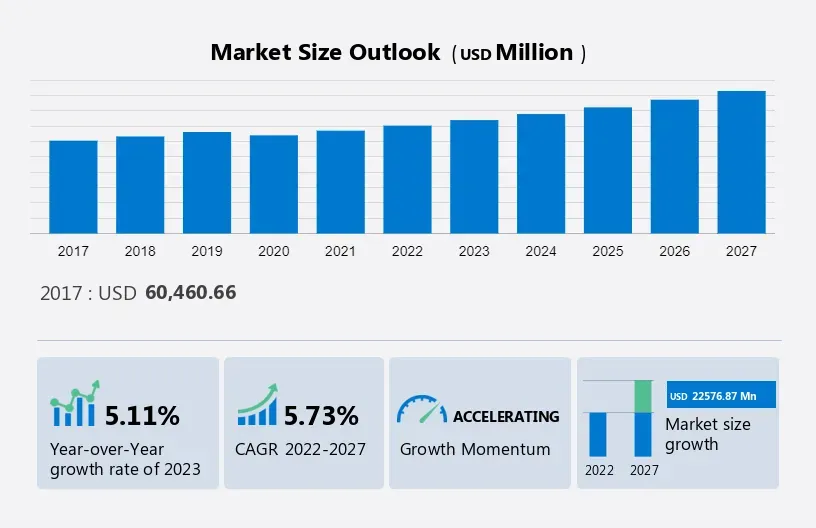Table of Contents
by Jennifer Williams
The Cabinets Market looks to grow by an estimated $2.26 billion by 2027, according to a recent report from leading market research company Technavio.
Technavio estimates the Cabinets Market size will grow at a CAGR of 5.73 percent between 2022 and 2027, with growth dependent on several factors, including the growing influence of different retailing channels, the rise in the adoption of outdoor living spaces, and the increase in expenditure on luxury lifestyles among people.
According to the report, increasing global interest in online and offline retail channels is playing an important role in the growth of the global cabinet market. Due to increasing Internet penetration globally, the influence of e-commerce-based shopping and online retailing has grown. Many major players have either launched their new furniture-specialist online stores or are planning to launch their new e-commerce-based outlets.
Moreover, major players operating in the global cabinet market concentrated on marketing their products via a variety of channels, e.g. through apps, in an effort to penetrate other alternatives for retail sales. Thus, the growing influence of different retail channels will be the major market driver during the forecast period.
Emerging Trends
One emerging trend has been the use of outdoor kitchen cabinets by millennials, according to the study. They prefer smaller one-bedroom apartments and households with only one person. Consequently, there is an increase in demand for multifunctional kitchen cabinets outside the home. Being highly adept at using technology, highly active on social media, and more trusting of online sources and purchasing more through digital devices, millennials have become the largest consumer group in the U.S. furniture and bedding market, according to Technavio.
And the number of millennials around the world has increased, which is an encouraging sign for players in the worldwide cabinet market. The increase in disposable income experienced by the Millennial population is resulting in a growing number of people adopting indoor kitchen cabinets. Therefore, the growth in the demand for outdoor kitchen cabinets among millennials is a vital trend, which will positively impact the global cabinets market during the forecast period
Concerns and COVID Effect
Various factors, such as the rising costs of raw materials, have led to an uneven price situation in the worldwide market for cabinets. An increase in costs of raw materials presents a two-way challenge for major players as they should either accept the high prices of raw materials or sell products at higher prices, with the risk of losing customers to competitors offering the same products at lower prices. Changes in labor laws can also have an impact on raw material costs for the production of cabinets.
During the COVID-19 pandemic in 2020, there was a decrease in the demand for plywood as manufacturing activities were halted due to the lockdown restrictions. This has led to a downturn in the price of plywood. Therefore, the unstable prices of raw materials are a major challenge that is expected to negatively impact the global cabinets market during the forecast period.
Growth Segments
The kitchen cabinets segment will account for a major share of the market's growth during the forecast period. Kitchen cabinets are outdoor or built-in kitchen furniture used to store food, utensils, and usually silverware and utensils for table service. There are various kitchen cabinet materials available, such as stainless steel, marine-grade aluminum, masonry, polyvinyl chloride (PVC), and wood.
The consumer goods segment was valued at USD 28,464.88 million in 2017 and continued to grow until 2021. Increasing renovation incidences and new product launches are likely to contribute positively to the market in focus.
Based on end-user, the market has been segmented into residential and commercial. The residential segment will account for the largest share of this segment. The residential segment held the largest revenue share in 2022. This is due to the rise in home remodeling projects globally. In addition, it is expected that growth in the market will be supported by an increase in spending on household furniture such as cabinets.
The market in focus is expected to grow strongly during the forecast period, driven by a strong recovery of the residential construction industry and rising consumer spending across developed and developing countries. Due to the rise in disposable income, housing sales have increased. This factor, coupled with the high Internet penetration, is fueling the growth of the residential cabinets segment. With rapid Internet penetration, the awareness of versatile furniture, house renovation, and environment-friendly furniture has increased considerably in developed countries such as the U.S.
North America is estimated to contribute 37 percent to the market’s growth by 2027. The real estate and commercial leasing industries in North America have been observing significant growth. This has led to an increase in commercial properties, which, in turn, increased the sale of cabinets in North America. The U.S. is the largest contributor in North America for cabinets in North America. During this forecast period, the increasing regional economy will be a driving force for market growth. In the U.S., as people change their lifestyles, attention to decoration is becoming more important. The demand for restaurant furniture has gone up with a rise in the number of commercial properties and restaurants in the region. Some of the other factors that are driving the demand for cabinets in North America are increasing urbanization, increasing employment rates, and rising income levels.
The furniture market in North America witnessed slow growth owing to the outbreak of COVID-19 in 2021. However, the market is expected to witness a rise in the sales of cabinets via e-commerce channels during the forecast period. Hence, the market is expected to recover during the forecast period as vendors and end-user industries are reinstating their routine operations. Moreover, the region was encouraged to remove some of the COVID-19 restrictions and allowed stores to open for business after implementing a vaccination drive in 2021. People also started to redesign commercial spaces to attract customers, which led to an increase in the demand for cabinets in the region in 2021. Therefore, vendors are expected to recover from the slowdown during the forecast period.
Visit www.technavio.com for this and other market analysis reports.







